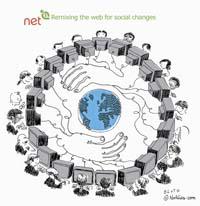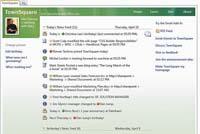Virtual Society on the Internet

This success also prompted large Internet organizations to create their own social networks. Google, for example, created Orkut.com in 2004 and in 2005 Yahoo created its own; and, of course, Microsoft is also creating its own resource, the TownSquare, which is still enabled for internal use. It can be a good business. On the one hand, the benefits derived from advertising can be taken into account; on the other hand, social networks have millions of users and large databases with information about their hobbies and their professional activity. This information can be very attractive for extraordinary businesses.
How to create a social network
Once the technical structure and web application are ready, members of the creative team send an invitation to participate in the social network to acquaintances and friends, or publish several forums and blogs on the Internet. Since each member can contribute new members, the network increases exponentially.

On social networks of the Internet, there is the possibility of contacting other members of the network, even if they are not known and are thousands of kilometers away. The system is wide and is expanding with the contributions of each member, so each new participant is important.
Precisely when accessing a social network, the first step is to create your own profile and complete the data you want, such as the activities you like, contact details and professional information. You should then seek out your colleagues to share interests, concerns, desires or needs. Other members of the Network may also find a new participant based on taste, data or defined object. From there, you can find friends, co-workers, partners or your own heart sugar based on your goal.
Facebook and MySpace, the greatest hits

One of the most widespread spaces for the creation of social networks is Facebook, although initially it was created to contact the colleagues of the University of Hardvard. It has eighty million members, a fully open multipurpose team. In addition, lately it has had some impact due to the possibility that users have to develop additional applications and take advantage of economic.
Until recently it was monolingual and, like many other websites of this type, English was the main language. But in 2008, with the aim of expanding the scope of the participants, versions were launched in French, Spanish and German, and more languages have already been joined: Catalan, Danish, Italian, Suomese and others. And although it is not yet available, the translation into Basque is quite advanced. In addition, once the registration is completed, adding the 'Translations' application to the user account, you can use Facebook in Basque.
The MySpace project was created by Tom Anderson and is currently owned by News Corporation. With more than 300 employees, nearly two hundred million users and two hundred and thirty thousand new users per day, MySpace is the most widespread website and with the highest number of users for the creation of social networks. In addition, according to Alex's index to measure Internet traffic, MySpace is the seventh most visited point and fourth place in English. Although there are not as many languages as Facebook, it is multilingual. It is not yet in Basque, but in French, Spanish, German or Polish.

Google and Microsoft
As mentioned above, the attention generated by social networks has meant that large organizations of new technologies have not wanted to stand aside. In 2004, Google promoted the personal project of an employee: It is called Orkut, the name of its founder, Orkut Büyükökten. Until recently you could only access the service by invitation, but it is an open day; the only requirement to use the site is to have a Google account. Like other social networks, you can create and maintain groups; you can locate and interact with participants, share images, videos and messages. Of course, the powerful Google search engine allows you to find participants, internal services or communities. At the moment it is in beta version and only in English.
Microsoft has also been creating its own social networking platform in recent months. At the moment the system is closed, it is only available to Microsoft staff, and it seems that about eight thousand users have already tested it. The project would use a model similar to that of Facebook, but it is especially oriented to professional relationships. In fact, its main objective is to improve coordination and facilitate teamwork of an organization's staff to make it more productive. To do this, it will offer different options, such as seeing if a colleague has changed a document or added an appointment on the agenda, or virtual spaces to work and debate.

Professional networks: LinkedIn and Xing
However, there are already professional social networks of this type. LinkedIn, for example, leaves aside the general objective of other social networks and puts its forces in the professional field, focusing on the development of labor and business relations with other participants. It was created in December 2002 and was published in May 2003. User account

is not as big as Facebook or MySpace, but they are not few, that is, twenty-four million. In addition to doing business, it allows job offers and looking for candidates, and helps those looking for jobs the other way around.
Among professional networks, Xing has also achieved great prestige. It has about five million participants and, although not in Basque, is multilingual. It aims to facilitate collaboration between participants and business creation. The project was born in June 2003 in Germany, initially under the name of OpenBC, but later it was decided to change its name and Xing was chosen by international marketing criteria, since Xing means in Chinese and you can read crossing in English. Xing also offers a job exchange, Marketplace, where you can find candidates, jobs and projects.






